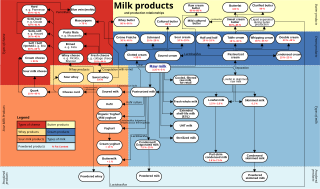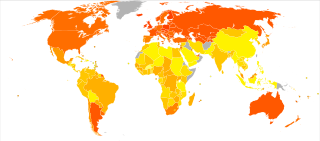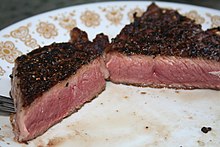
Dairy products or milk products, also known as lacticinia, are food products made from milk. The most common dairy animals are cow, water buffalo, nanny goat, and ewe. Dairy products include common grocery store food around the world such as yogurt, cheese, milk and butter. A facility that produces dairy products is a dairy. Dairy products are consumed worldwide to varying degrees. Some people avoid some or all dairy products because of lactose intolerance, veganism, environmental concerns, other health reasons or beliefs.

Ham is pork from a leg cut that has been preserved by wet or dry curing, with or without smoking. As a processed meat, the term ham includes both whole cuts of meat and ones that have been mechanically formed. Regular consumption of especially the processed version is associated with negative health outcomes.

Meat is animal tissue, often muscle, that is eaten as food. Humans have hunted and farmed other animals for meat since prehistory. The Neolithic Revolution allowed the domestication of animals, including chickens, sheep, goats, pigs, horses, and cattle, starting around 11,000 years ago. Since then, selective breeding has enabled farmers to produce meat with the qualities desired by producers and consumers.

Low-carbohydrate diets restrict carbohydrate consumption relative to the average diet. Foods high in carbohydrates are limited, and replaced with foods containing a higher percentage of fat and protein, as well as low carbohydrate foods.

The Mediterranean diet is a diet inspired by the eating habits and traditional food typical of southern Spain, southern Italy, and Crete, and formulated in the early 1960s. It is distinct from Mediterranean cuisine, which covers the actual cuisines of the Mediterranean countries, and from the Atlantic diet of northwestern Spain and Portugal. While inspired by a specific time and place, the "Mediterranean diet" was later refined based on the results of multiple scientific studies.

Lunch meats—also known as cold cuts, luncheon meats, cooked meats, sliced meats, cold meats, sandwich meats, delicatessens, and deli meats—are precooked or cured meats that are sliced and served cold or hot. They are typically served in sandwiches or on a tray. They can be purchased pre-sliced, usually in vacuum packs, or they can be sliced to order.

A plant-based diet is a diet consisting mostly or entirely of plant-based foods. Plant-based diets encompass a wide range of dietary patterns that contain low amounts of animal products and high amounts of fiber-rich plant products such as vegetables, fruits, whole grains, legumes, nuts and seeds. They do not need to be vegan or vegetarian, but are defined in terms of low frequency of animal food consumption.

In organic chemistry, nitrosamines are organic compounds with the chemical structure R2N−N=O, where R is usually an alkyl group. They feature a nitroso group bonded to a deprotonated amine. Most nitrosamines are carcinogenic in nonhuman animals. A 2006 systematic review supports a "positive association between nitrite and nitrosamine intake and gastric cancer, between meat and processed meat intake and gastric cancer and oesophageal cancer, and between preserved fish, vegetable and smoked food intake and gastric cancer, but is not conclusive".
In biochemistry and nutrition, a monounsaturated fat is a fat that contains a monounsaturated fatty acid (MUFA), a subclass of fatty acid characterized by having a double bond in the fatty acid chain with all of the remaining carbon atoms being single-bonded. By contrast, polyunsaturated fatty acids (PUFAs) have more than one double bond.

A healthy diet is a diet that maintains or improves overall health. A healthy diet provides the body with essential nutrition: fluid, macronutrients such as protein, micronutrients such as vitamins, and adequate fibre and food energy.

Processed meat is considered to be any meat that has been modified in order to either improve its taste or to extend its shelf life. Methods of meat processing include salting, curing, fermentation, smoking, boiling, frying, and/or the addition of chemical preservatives. Processed meat is usually composed of pork or beef or, less frequently, poultry. It can also contain offal or meat by-products such as blood. Processed meat products include bacon, ham, sausages, salami, corned beef, jerky, hot dogs, lunch meat, canned meat, chicken nuggets, and meat-based sauces. Meat processing includes all the processes that change fresh meat with the exception of simple mechanical processes such as cutting, grinding or mixing.

In culinary terms, white meat is meat which is pale in color before and after cooking. In traditional gastronomy, white meat also includes rabbit, the flesh of milk-fed young mammals, and sometimes pork. In ecotrophology and nutritional studies, white meat includes poultry and fish, but excludes all mammal flesh, which is considered red meat.

Heterocyclic amines, also sometimes referred to as HCAs, are chemical compounds containing at least one heterocyclic ring, which by definition has atoms of at least two different elements, as well as at least one amine (nitrogen-containing) group. Typically it is a nitrogen atom of an amine group that also makes the ring heterocyclic, though compounds exist in which this is not the case. The biological functions of heterocyclic amines vary, including vitamins and carcinogens. Carcinogenic heterocyclic amines are created by high temperature cooking of meat and smoking of plant matter like tobacco. Some well known heterocyclic amines are niacin, nicotine, and the nucleobases that encode genetic information in DNA.

Dietary factors are recognized as having a significant effect on the risk of cancers, with different dietary elements both increasing and reducing risk. Diet and obesity may be related to up to 30–35% of cancer deaths, while physical inactivity appears to be related to 7% risk of cancer occurrence.

The Western pattern diet is a modern dietary pattern that is generally characterized by high intakes of pre-packaged foods, refined grains, red meat, processed meat, high-sugar drinks, candy and sweets, fried foods, industrially produced animal products, butter and other high-fat dairy products, eggs, potatoes, corn, and low intakes of fruits, vegetables, whole grains, pasture-raised animal products, fish, nuts, and seeds.

Animal source foods (ASF) include many food items that come from an animal source such as fish, meat, dairy, eggs and honey. Many individuals consume little ASF or even none for long periods of time by either personal choice or necessity, as ASF may not be accessible or available to these people.

Humans and their hominid relatives have consumed eggs for millions of years. The most widely consumed eggs are those of fowl, especially chickens. People in Southeast Asia began harvesting chicken eggs for food by 1500 BCE. Eggs of other birds, such as ducks and ostriches, are eaten regularly but much less commonly than those of chickens. People may also eat the eggs of reptiles, amphibians, and fish. Fish eggs consumed as food are known as roe or caviar.

Diet plays an important role in the genesis of obesity. Personal choices, food advertising, social customs and cultural influences, as well as food availability and pricing all play a role in determining what and how much an individual eats.

Heterocyclic amines are a group of chemical compounds, many of which can be formed during cooking. They are found in meats that are cooked to the "well done" stage, in pan drippings and in meat surfaces that show a brown or black crust. Epidemiological studies show associations between intakes of heterocyclic amines and cancers of the colon, rectum, breast, prostate, pancreas, lung, stomach, and esophagus, and animal feeding experiments support a causal relationship. The U.S. Department of Health and Human Services Public Health Service labeled several heterocyclic amines as likely carcinogens in its 13th Report on Carcinogens. Changes in cooking techniques reduce the level of heterocyclic amines.
Cancer prevention is the practice of taking active measures to decrease the incidence of cancer and mortality. The practice of prevention is dependent upon both individual efforts to improve lifestyle and seek preventive screening, and socioeconomic or public policy related to cancer prevention. Globalized cancer prevention is regarded as a critical objective due to its applicability to large populations, reducing long term effects of cancer by promoting proactive health practices and behaviors, and its perceived cost-effectiveness and viability for all socioeconomic classes.























